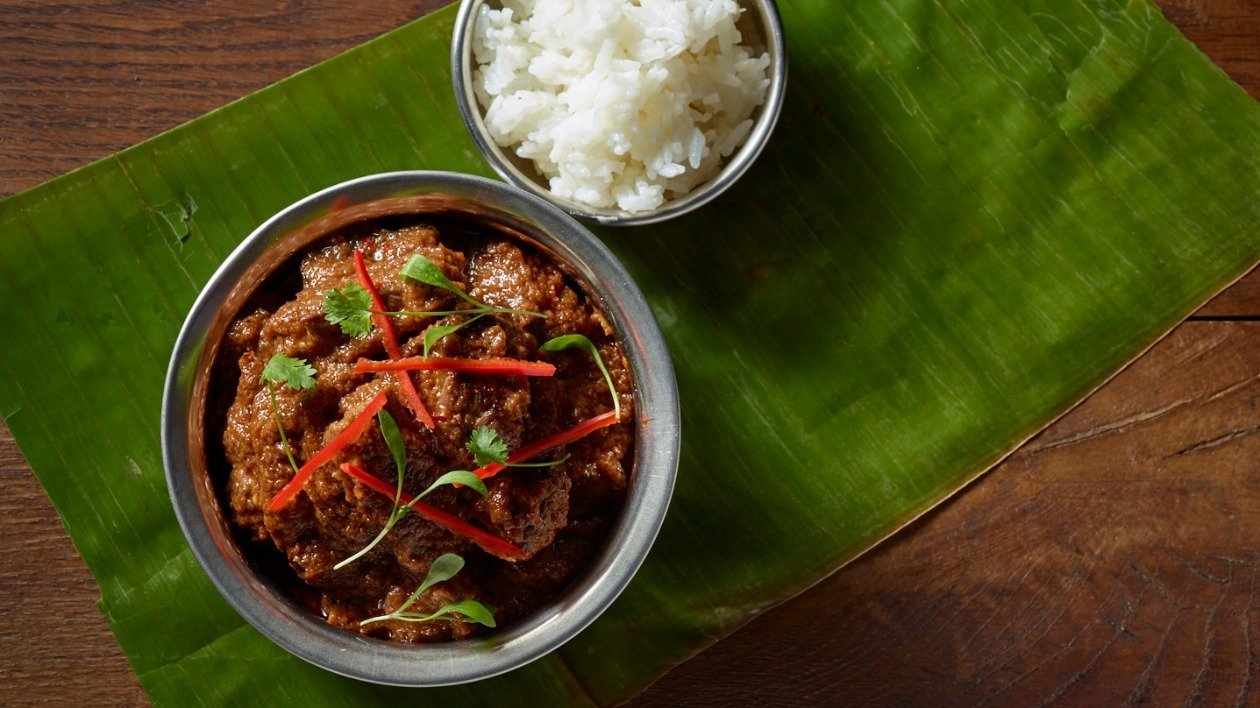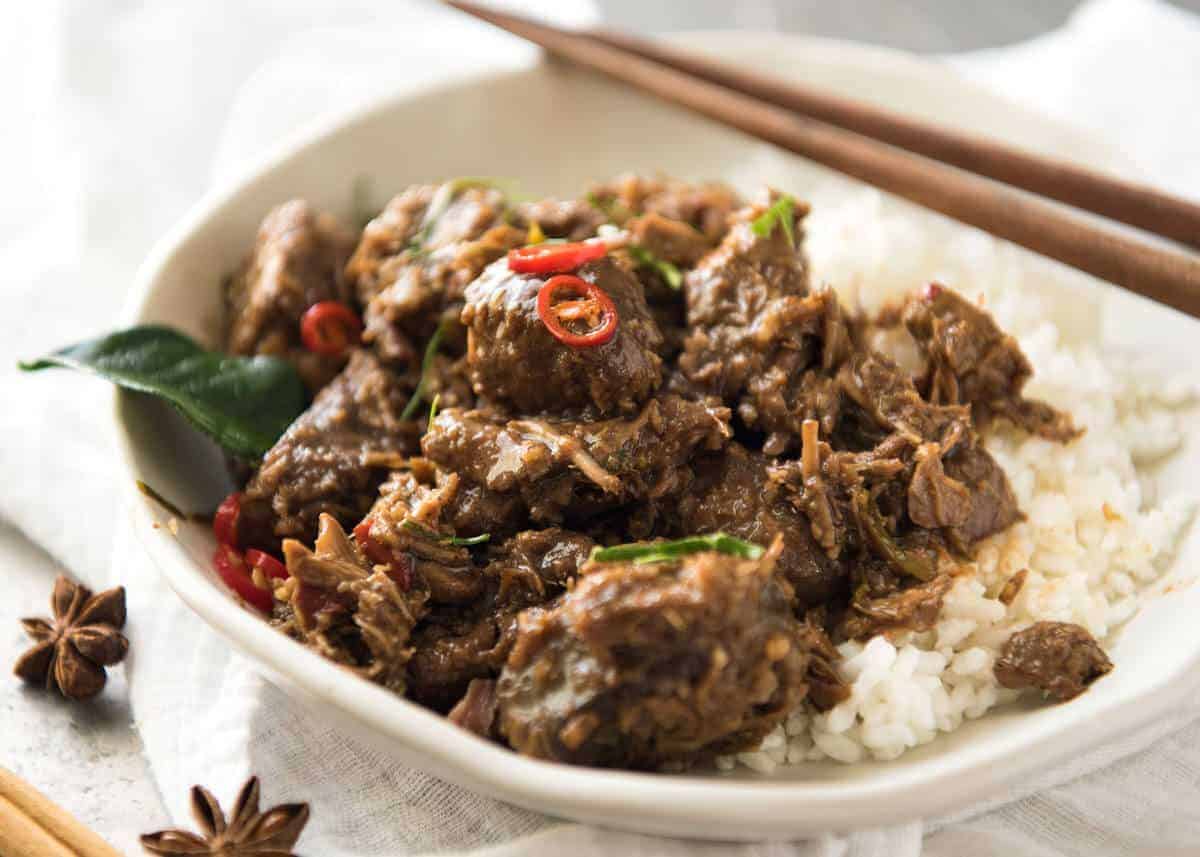Rendang, an aromatic and flavorful dish originating from Indonesia, has captivated taste buds worldwide. Its rich history and cultural significance have made it a beloved culinary treasure. In this guide, we embark on a culinary adventure, exploring the secrets of a quick and delectable rendang recipe, ensuring a taste of Indonesia in your own kitchen.
Indonesian cuisine is renowned for its vibrant blend of spices, and rendang is no exception. This dish showcases a symphony of flavors, where tender beef simmers in a fragrant coconut milk broth infused with aromatic spices. Join us as we delve into the art of crafting this culinary masterpiece, making it accessible to home cooks of all levels.
Introduction
Rendang is a spicy meat dish that originates from the Minangkabau region of West Sumatra, Indonesia. It is considered one of the national dishes of Indonesia and is often served during special occasions and celebrations.
Rendang is made from beef or buffalo meat that is slow-cooked in a mixture of spices and coconut milk. The cooking process can take several hours, and the meat is typically cooked until it is tender and the sauce has thickened and become flavorful.
Origins and Cultural Relevance
Rendang is thought to have originated in the 14th century, during the Majapahit Empire. The dish was originally a way to preserve meat for long periods of time, as it could be stored at room temperature for several days.
Rendang has since become a symbol of Minangkabau culture and is often served at traditional ceremonies and festivals. It is also a popular dish for everyday meals, and is often served with rice or other side dishes.
Ingredients

Crafting a delectable rendang requires a symphony of essential ingredients that blend harmoniously to create its distinctive flavors. At its core lies tender beef, steeped in a rich embrace of coconut milk. Aromatic spices, such as turmeric, coriander, and cumin, dance together to infuse the dish with warmth and depth.
To elevate the experience, optional ingredients can add tantalizing nuances. Lemongrass whispers a refreshing citrus note, while kaffir lime leaves lend a subtle floral essence. Green chilies bring a fiery kick, while palm sugar balances the symphony with its gentle sweetness.
Experiment with these ingredients to create a rendang that truly reflects your palate’s desires.
Essential Ingredients
| Ingredient | Quantity | Metric |
|---|---|---|
| Beef (chuck roast or flank steak) | 1 kg | 2.2 pounds |
| Coconut milk | 2 cans (13 oz each) | 700 ml |
| Turmeric powder | 2 tablespoons | 30 ml |
| Coriander powder | 1 tablespoon | 15 ml |
| Cumin powder | 1 teaspoon | 5 ml |
Step-by-Step s
Follow these s carefully to create a flavorful and authentic rendang:
Tips for Optimal Flavor and Texture:
- Use high-quality beef for a richer taste.
- Cook the rendang over low heat for a long time to allow the flavors to develop.
- Don’t skip the step of toasting the spices, as this enhances their aroma and flavor.
- Add coconut milk in stages to prevent curdling.
- Taste the rendang throughout the cooking process and adjust the seasonings as needed.
Seasoning and Cooking
- Season the beef: Combine the beef with the turmeric, coriander, cumin, and salt. Mix well to coat the beef evenly.
- Sear the beef: Heat a large pot or Dutch oven over medium-high heat. Add the seasoned beef and sear until browned on all sides.
- Add the aromatics: Add the onions, garlic, ginger, and chilies to the pot. Sauté until softened, about 5 minutes.
- Toast the spices: Add the ground spices (cinnamon, cloves, cardamom, and nutmeg) to the pot. Toast over low heat for 1-2 minutes, or until fragrant.
- Add the coconut milk: Gradually add the coconut milk to the pot, stirring constantly. Bring to a simmer and cook for 2-3 hours, or until the beef is tender.
- Reduce the heat: Once the beef is tender, reduce the heat to low and continue to simmer for 2-3 more hours, or until the sauce has thickened and the oil has separated from the meat.
- Check the seasoning: Taste the rendang and adjust the seasonings as needed. Add more salt, pepper, or spices to your liking.
Variations
Rendang’s rich history and diverse culinary traditions across Indonesia have given rise to numerous regional variations.
Each region boasts unique spice blends and ingredient combinations that impart distinct flavors and appearances to the dish.
Sumatran Variations
- Padang Rendang: The classic and most well-known rendition, characterized by a rich, dark gravy and a balance of heat and spices.
- Minangkabau Rendang: Originating from the Minangkabau region, this variation features a lighter-colored gravy and a more pronounced herbaceous flavor.
Javanese Variations
- Jawa Tengah Rendang: Influenced by Javanese cuisine, this rendang incorporates sweeter spices, such as palm sugar, and a lighter consistency.
- Jawa Timur Rendang: From East Java, this variation uses a blend of spices that includes star anise and cloves, resulting in a more aromatic and complex flavor profile.
Serving Suggestions

Rendang, with its rich and flavorful profile, is traditionally served as a main dish, accompanied by various complementary dishes and accompaniments. In Indonesian cuisine, it is often paired with steamed rice, creating a harmonious balance of textures and flavors. The rice provides a neutral base, allowing the bold spices and tender meat of the rendang to take center stage.
Complementary Dishes and Accompaniments
To complement the savory richness of rendang, consider serving it alongside fresh and crunchy vegetable dishes. Steamed or stir-fried vegetables, such as green beans, carrots, or bell peppers, offer a vibrant contrast in color and texture. A refreshing cucumber salad or pickled vegetables can provide a tangy and cooling element, balancing the heat of the rendang.
Presentation
For an aesthetically pleasing presentation, consider serving the rendang in a traditional Indonesian clay pot or a shallow serving dish. Garnish the dish with fresh herbs, such as cilantro or scallions, for a touch of vibrant greenery. Arrange the rendang neatly on a bed of steamed rice, creating a visually appealing contrast between the rich brown hues of the meat and the white of the rice.
Tips for Success
Mastering the art of rendang requires patience, technique, and a few insider secrets. Here are some expert tips to guide you toward a delectable and authentic rendang experience:
Tenderizing the Meat
- Choose the right cut of meat: Opt for tougher cuts like chuck roast or brisket, which contain more connective tissue that breaks down during cooking, resulting in tender meat.
- Marinate the meat: Marinating the meat overnight in a mixture of spices and aromatics helps penetrate flavors and tenderize the meat.
- Cook slowly and low: Simmering the meat for several hours allows the connective tissue to dissolve, resulting in melt-in-your-mouth tenderness.
Infusing Flavor
- Use a flavorful base: The rendang paste is the heart of the dish, so use a generous amount of aromatic spices, herbs, and chilies to create a rich and complex flavor base.
- Bloom the spices: Before adding the paste to the meat, heat the spices in oil to release their aromas and enhance their flavor.
- Cook the paste thoroughly: Allow the rendang paste to cook for 15-20 minutes until it becomes fragrant and the oil separates from the paste, infusing the meat with intense flavors.
Troubleshooting Common Challenges
- The meat is tough: If the meat is still tough after cooking, it may not have been cooked long enough. Increase the cooking time or use a pressure cooker to tenderize the meat more quickly.
- The rendang is too spicy: If the rendang is too spicy for your taste, reduce the amount of chilies used in the paste or add more coconut milk to balance the heat.
- The rendang is too oily: If the rendang has too much oil, skim off the excess oil from the surface after cooking or use a lower-fat coconut milk.
Nutritional Information
Rendang is a nutrient-rich dish that offers a range of essential nutrients. It is a good source of protein, fat, and fiber. Rendang also contains significant amounts of vitamins and minerals, including iron, zinc, and vitamin B12.
Health Benefits
The ingredients used in rendang provide several health benefits. Turmeric, for example, has anti-inflammatory properties and may help reduce the risk of heart disease and cancer. Ginger is known for its digestive benefits and can help relieve nausea and vomiting.
Coconut milk is a good source of healthy fats and can help improve cholesterol levels.
Final Conclusion
As we conclude our culinary exploration, we hope you are inspired to recreate this delectable rendang recipe in your own kitchen. Whether you choose to serve it traditionally with steamed rice or explore creative variations, the rich flavors of rendang will transport you to the heart of Indonesia.
Remember, cooking should be an enjoyable and experimental process, so feel free to adjust the ingredients and techniques to suit your taste preferences. Selamat makan, and may your rendang-making journey be filled with culinary adventures!
Questions and Answers
Can I use chicken or tofu instead of beef?
Yes, you can substitute beef with chicken or tofu for a variation in protein. However, adjust the cooking time accordingly to ensure the chosen protein is cooked through.
What is the best way to tenderize the beef?
Marinating the beef overnight in a mixture of spices and yogurt or buttermilk helps tenderize the meat and enhances its flavor.
Can I make rendang ahead of time?
Yes, rendang is a dish that tastes even better the next day. Allow it to cool completely before storing it in an airtight container in the refrigerator for up to 3 days.
